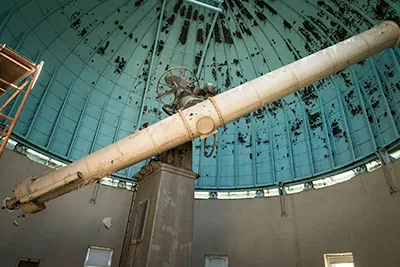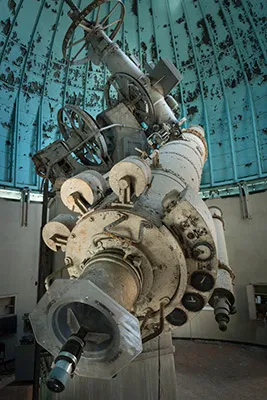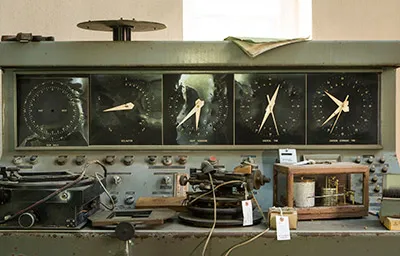Watch: Sproul Observatory Telescope Finds New Home
Susan Smythe was up for the challenge of relocating Sproul Observatory’s enormous telescope — with one caveat.
“I knew virtually nothing about telescopes,” laughs the ADA coordinator and project manager for construction. “But that’s actually one of the things I love about this job. You’re going to learn a lot of wacky things you wouldn’t have otherwise.”
Aided by consultants, contractors, riggers, and two “keepers of the telescope,” Smythe aced the crash course. She ran point on the removal and loading of the 106-year-old telescope over four days last week, sending it off to a new life as an educational outreach tool in Arkansas.

The telescope measures 36 feet long and weighs 50,000 pounds.
The project traces back to 2009, when Swarthmore added the Peter van de Kamp Observatory to the Science Center. With a more technologically advanced 24” reflecting telescope, that observatory replaced Sproul for education and public outreach purposes.
“So here’s this derelict machine that just happens to be carrying a half a million dollars worth of glass,” says Fred Orthlieb, professor emeritus of engineering, who for more than 10 years has helped to fix old telescopes with fellow “keeper” and Swarthmore resident Chris Ray.
“We kept telling people that someone could probably have this thing for a song,” Orthlieb says.
That prospect gained momentum last year when the College announced its plans for the James Hormel/Michael Nguyen Intercultural Center at Sproul Hall. Planners originally wanted to keep the telescope as an object of interest, Smythe says, but, among other issues, the insulation of the dome and size of the telescope conflicted with the vision for a multi-purpose space.
The College worked with Sara Schechner, a science historian from Harvard, and her husband, Ken Launie, to find a new home for the telescope. After receiving interest from within the U.S. and as far away as the Netherlands, Smythe says, “just the right one took.”
That was from Supporting STEM and Space, Inc. (S-Cubed), a nonprofit in the budding science community of northwest Arkansas with designs on building a science center. It saw the Sproul telescope as a draw for people all across the Midwest, but especially for community groups like the Sugar Creek Astronomical Society and for local students.
“I’ve yearned for an observatory to take my students to for night observations, where they could look through a large telescope,” says Katherine Auld, chair of the board of directors at S-Cubed, who teaches astronomy at the local community college.

When it arrived on campus in 1913, the telescope was the largest on the East Coast and one of the largest in the world.
“There’s something unique about looking through a telescope with your own eye (rather than spectrographic equipment) that draws people in and lights hearts afire for the stars,” she adds. “Once the fire is lit, it’s easy to fan the flames and allow them to spread to include engineering, technology, and math, as these are the methods we use to answer all the great science questions that are waiting.”
S-Cubed expects the telescope will be refurbished and operating within five years, after it raises the money to build the science center. The educational and community outreach elements align with Swarthmore’s mission and exceed its highest hopes for the telescope.
“I figured it would go to some university as a relic,” Orthlieb says. “But it’s going to have a rebirth as a working scientific instrument, with the staff support to keep it healthy.”
But first it needed to get to Arkansas in one piece — figuratively. Orthlieb joined that effort as an on-site advisor, and he and Ray helped the College to prepare for the removal in recent weeks.
Beginning last Monday, the riggers separated the halves of the the 36-foot, riveted steel tube of the telescope from its massive cast-iron joiner tee, removed all three from the 20,000-pound equatorial mount and its 35,000-pound cast iron pier, and took the pier apart. A crane reached into the dome through its wide-open slot to retrieve all of the pieces before placing them onto two 53’ flatbed trucks.
To achieve its goal of tracking a star with absolute precision, the telescope’s moving mass of 11,000 pounds must first be balanced with respect to its two axes within about five pounds, Orthlieb says.
“And when you start to disassemble it, that balance gets destroyed big time,” he says. “We had to be very careful to not overload is clamping mechanisms.” In particular, the objective cell, which contains the two massive lenses, required a delicate touch.

Equipment once used with the telescope inside of the Sproul Observatory.
“We were all kind of holding our breath a little bit there,” Smythe says, adding that the overall disassembly went smoothly, despite some “twists and turns” common with custom-engineered equipment.
To help ensure a smooth journey for the telescope to S-Cubed, Orthlieb provided estimates of the weights and sizes of its components. And two members of the organization attended the removal, documenting the disassembly to make it easier to put back together in Arkansas.
Traveling even further west was the observatory’s book collection, to a new astronomy center in Magdalena, N.M. Smythe arranged this donation to the “dark skies” astronomy enclave, which will feature a new library and vast collection of astronomical instruments.
That aspect of the project reminded Smythe of her days in college as a history major; the larger project, her experiences rigging theatrical sets as director of the Lang Performing Arts Center.
“All of the different aspects of this have been fun for me,” she says, “and pretty far-reaching.”
Watch the telescope arrive in Arkansas.



